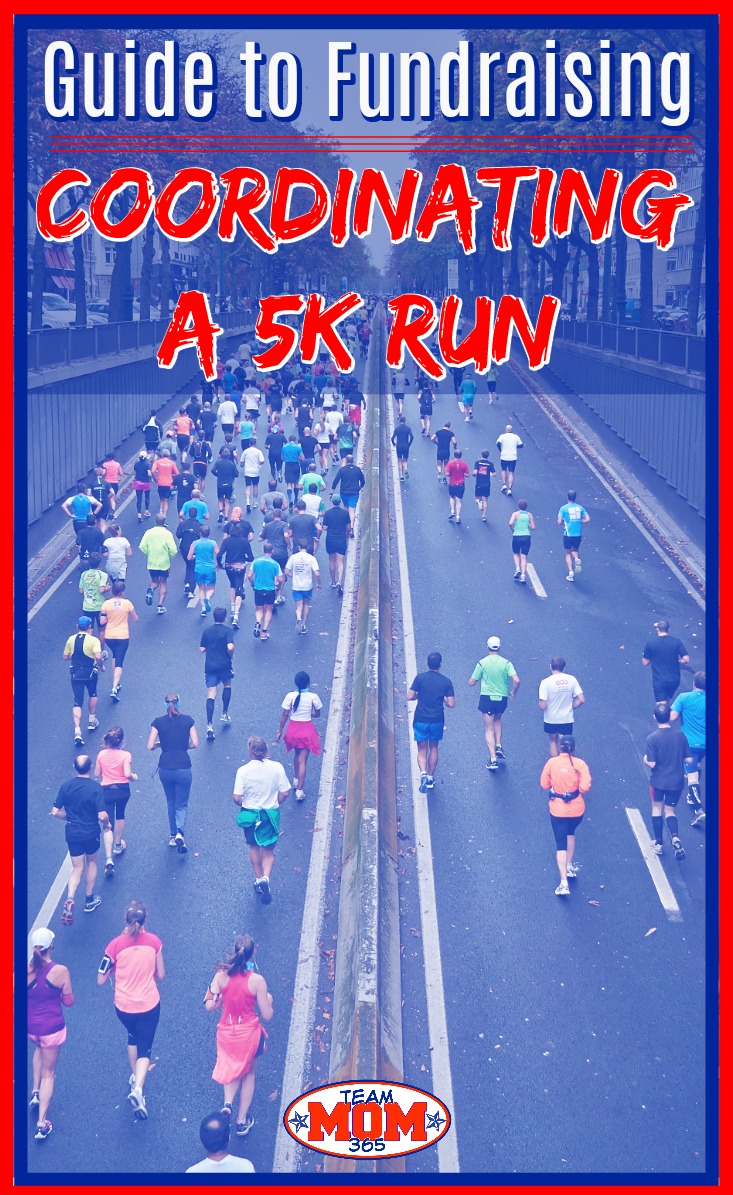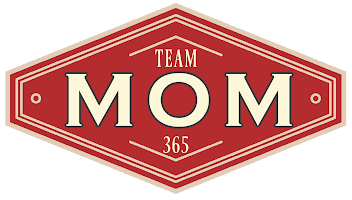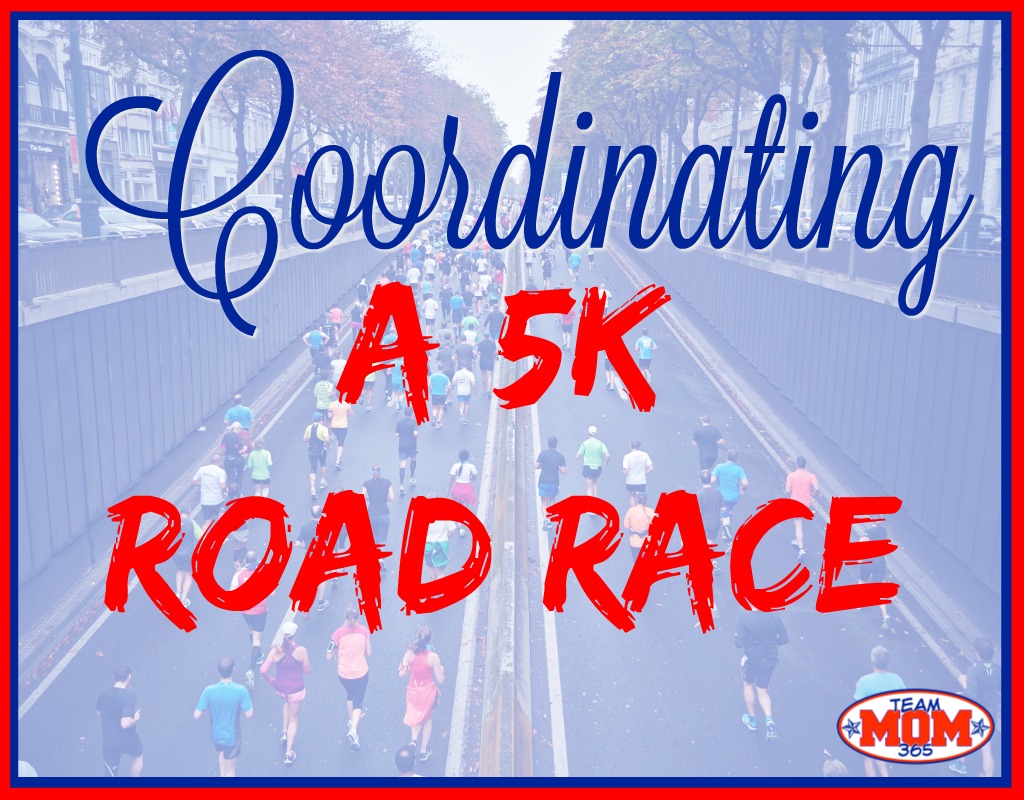Our Guide to Fundraising gave an overview of the different types of fundraisers available for sports teams and organizations. Last time we highlighted how to run “A-Thons”. Now it’s time to delve into a different fundraiser. Our focus this time is coordinating a 5k Run.
Fundraising Basics
FUNDRAISER: 5k Run
EASE OF ORGANIZATION: Advanced
SUMMARY: Hosting a race for your local community
Like the summary says, this is organizing a road race in your community. This could be any distance but starting small with a 5k or a kids fun run will get your feet wet in the race game. There is no sugar coating it. It is hard work. There are a lot of hours and sweat equity in this type of fundraiser. There will be multiple meetings, hours of planning and physical labor.
Before undertaking the coordination of a 5k make sure you, and your team, understand what you are getting yourself into.
Organization
As with other fundraisers, it all starts with good organization. Again, with brutal honesty, if you don’t have group of 5-10 committed people who will serve as your committee and can help you with planning the ins and outs of this fundraiser, it will be next to impossible to accomplish. There are so many detailed steps involved that it would be nearly a full-time job for one person to get them all done.
Sub-Committees
Having sub-committees will spread the duties and allow small groups to focus on one area of race management. For example, your sub-committees could cover prizes, promotion, race day/course management, swag bag, timing and volunteers. Even if you don’t have enough volunteers to staff committees, it is always a good idea to assign one person to a specific task. That way they can delve right in and feel a sense of ownership over their area.
Initial Organizational Meeting
It is extremely important that you hold your initial organizational meeting at least six months prior to the race day. During this meeting you and your committee will set all important details of the race.
Initial Meeting Agenda
1. Race Date Selection
If you live in a Northern climate you will want to look for dates in the summer. If you live in the South where summer temperatures are sweltering, you might want to pick a winter date. You should also look at the calendar of the organization you are raising money for. It doesn’t make sense to have your race if your organization isn’t even in season. For example, if you are raising money for a little league which plays in the spring, it’s way easier to communicate with potential participants when you can tap into your already-established communication network.
2. Race Distance(s)
There are many different choices here, but the overwhelming majority of road races are 5Ks (3.1 miles). If you are raising money for a youth organization, it doesn’t take much extra coordination to add in a youth fun run which are typically under one mile.
3. Race Course
The race course you create will make or break your future races. If the course is too hard for leisurely runners, which are your bread & butter, then they won’t come back again. Take these items into considerations:
- Limit hills
- Limit the number of turns
- No cross patterns
- Limit road obstacles
- The Start/Finish line should be in the same general location
- Plan a route that highlights your community, facility or locations of interest
4. Preliminary Budget
Creating a skeleton budget will help you with the next step of setting the entry fee.
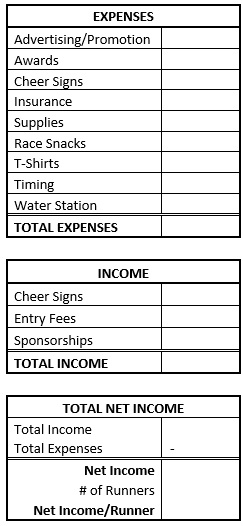
- Advertising/Promotion – This includes any paid advertising (ie. newspaper ads, Facebook ads, printing flyers, etc.)
- Awards – Trophies & Medals for each age group – Medals are fine but trophies for the overall male and female winners are a nice touch.
- Cheer Signs- Cheer signs are yard signs which people pay for to encourage their favorite runner. Once they are decorated, they are placed along the race route.
- Insurance – This is a must have. Not only will you name your organization as the insured, you will likely have to name the city/town where you are holding the race as an additional insured entity. Race insurance hovers between $2 – $3 per runner. If this is your first year you will have to do your best to estimate the number of runners you will have.
- Supplies The check-in area will need to be stocked with pens, money bags and/or envelopes.
- Race Snacks – Think healthy, obviously, like bananas and apples. (It’s possible a local grocery store might sponsor your after-race snacks.)
- Tee Shirts- You will have to front the money for tee shirts but don’t worry, you will get that money back in the registration fee. The number of tee shirts will be determined by the number of registrants at the 30 day make. To that number you will add 10-20% for late and same day registrants. The point is to not pay for any more shirts than you absolutely must.
- Timing- There are ways to do timing for free, but it is WAY easier just to hire a timing company and it will make your race seem more professional.
- Water Station – Water stations are very basic. All you need to buy are water, cups and trash bags. This is another area where you could seek a sponsor to cover the expenses.
5. Entry Fees
Now that you have your budget set, you can set your entry fees. However, this isn’t as easy as you might expect. Most races have tiered fees. Here are some types of tiered fees:
Regular
This is the amount of you will charge without any special offers and should be the average of all the other fees.
Early Bird
This is a discount for runners who register early. This is typically offered three to six months early.
Late
This is for runners who register after a date you specify. This is typically for the last month to two weeks before the race. Another facet of late fee is if you offer shirts, you might not offer shirts to late registrations or at the very least not guarantee late registers shirts.
On-Site
This is for runners who sign up the day of the race. The premium amount could be $5-$10 above the late fee and again there is no guarantee they will get a shirt.
Special
This is a special fee you might offer to select runners. They might be members of your organization, sponsors, advertisers, etc. Don’t give away the bank here. A few dollars, no more than $5, is enough.
Remember, this is a fundraiser so you want to price it so your organization makes some money. However, you don’t want to price runners out of the market. It’s a fine line so make sure to research other races in your area to see what they are charging. If that amount won’t make you money readjust your budget.
Ongoing Meetings
After your initial meeting, you should schedule meetings at least once a month. However, as you get closer to the race date you should consider ramping up the meeting frequency to bi-weekly, weekly or even daily in the week leading up to the race.
Items to discuss at each meeting:
- Financial Summary
- Prizes/Awards
- Promotion
- Race Day Management
- Registration Update
- Swag Bag
- Volunteers
Logistics
Logistics is an area you will want to spend a large amount of your time especially at the beginning of the planning process. Things like working closely with law enforcement, having EMS personnel available and getting the correct rights and permission from city and state authorities should be high on your priority list.
Local Law Enforcement/EMS
Your first call after setting dates should be to local law enforcement and EMS personnel. They will be your biggest friends throughout the entire process.
City or Town Officials
Once you have all your ducks in a row with the local public safety folks, it’s time to put a proposal together for your local town or city officials. This proposal should include 50% logistics and 50% how the race will benefit the town/city. Do you have unique shops? A cute downtown area? Local attractions? Show the officials how bringing runners from other communities will spotlight the advantages of your town which will mitigate the fact you will be shutting down roads.
Road Closure Permits
If you are planning on closing any public roads you will have to contact your state’s Department of Transportation to fill out a road closure form. Just remember, there is a possibility they could turn you down especially if you are closing a major thoroughfare. Be prepared with alternate race routes.
Road Closure Equipment
With the help of your local law enforcement or street department you will need to secure barricades or barrels to hold back traffic. At the very least you will need two barricades or barrels per corner (see the image below).
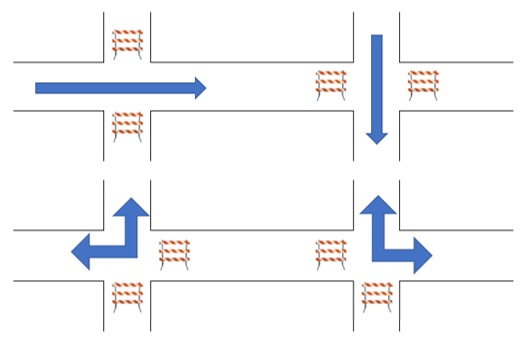
Race Day Communications
A happy fact of life is that everyone has a cellphone and you can use that to your advantage. By using the Two Way: Walkie Talkie app on iPhones and Androids you can keep in contact with all your volunteers without procuring walkie talkies. It is especially important that the following people have connected communication access:
- Race Coordinator
- Lead Representative from Law Enforcement
- Lead Representative from EMS
- Lead Race Vehicle
- Chase Vehicle
- Emcee
- Rover Vehicles
Water Station
Placed approximately halfway through the course, a water station allows runner to get a quick shot of water to push them on. While not required, it is definitely a great gesture for the runners.
Supplies needed for a water station:
- Two tables
- Water
- Cups (Prefill as many cups with water as possible)
- Shovels (no need to buy these, ask water station volunteers to bring snow shovels from home)
- Large Garbage Bags
NOTE: A water station is wonderful opportunity for a sponsor. Local restaurants are great for this. Whether they want to simply donate the money for the supplies or completely put it together themselves, this will alleviate the expense of the station for your budget.
Promotion
We talked about promotion earlier when we looked at creating a budget, but this is one area which requires some additional focus as races require a great deal of promotion. This includes internal and external. Here are some great ways to promote your race across all the available organizational, news and social mediums.
- Brochures
- Community Calendars
- Websites: Active.com, CoolRunning.com
- Create Flyer
- Flyers to post around community
- Yard Signs
- Contact all businesses with outdoor signs to advertise – this is especially true for businesses who are along your race route
- Facebook Event
- Mass Email to Organization Membership
- Local Newspapers and Media
- Website – create new if you don’t have a website, create a page on your site if you have one
- Local runner’s clubs and shops
- Select a media point person
- Sponsorships – Determine sponsorship levels, Mail sponsorship letters to potential sponsors
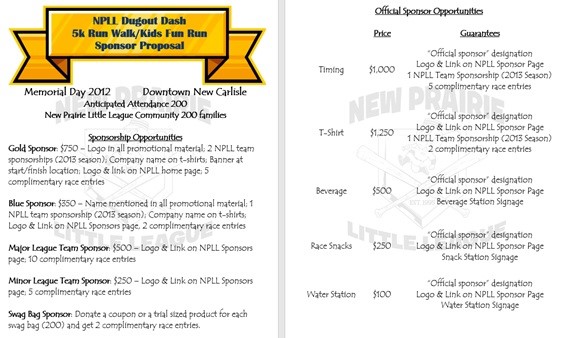
- Press Release to local media
- Contact a local personal trainer to post training methods for the race
Swag Bags
Swag Bags are collections of complimentary items given to runners. These have become an industry norm and some runners even expect races to provide bags. The key with these bags to not dip into your revenue while offering runner an incentive to race. Therefore, try getting as much of the contents donated as possible. This shouldn’t be too hard because most businesses will see the benefit of the exposure they will receive.
Ideas for Swag Bag contents
- Discount coupons from local business – especially those along the race route
- Trial sized samples of sponsor products
- Apparel
- Branded items
Equipment Needed
Vehicles
In all likelihood, the local police department will offer a squad car or two and might even have an ATV or four-wheeler. The minimum you will need are as follows:
- 4 ATV/4-Wheelers/Golf Carts – one as a lead vehicle, one as a chase vehicle behind the last runner, two rovers. You will also use one of these vehicles to inspect the course approximately 15 minutes prior to the race start to make sure the course is clear of any potential hazards and all personnel are in place.
Registration Area
The key to the registration area is FLOW. You want the area to be set up in such a way that participants, spectators and volunteers naturally flow through the area without too much congestion.
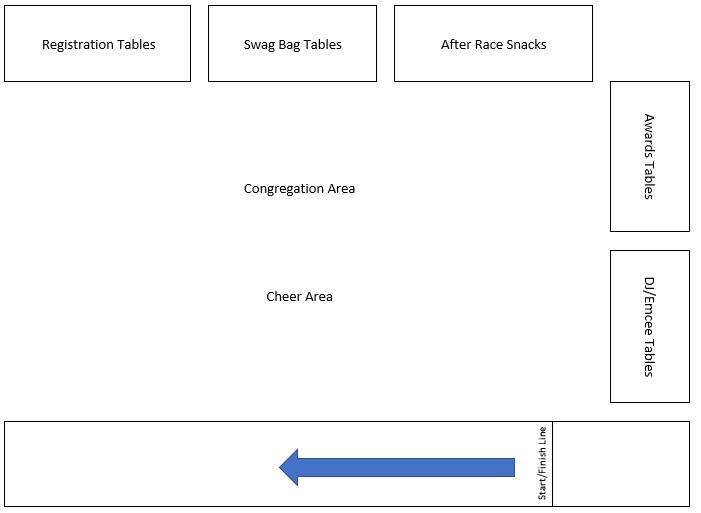
Volunteers
Another truth bomb: 5k runs require A LOT of volunteers and should be a focus of nearly every single meeting. Below is a list of the volunteers you will need:
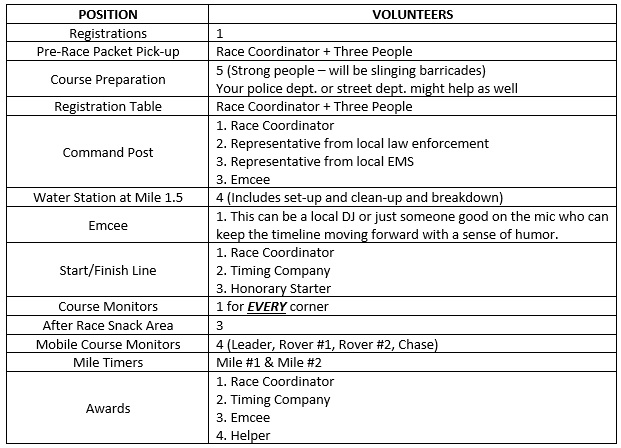
Accounting for Receipts
Accounting for your monetary receipts can make or break any fundraiser no matter the type. This is especially true if you plan to repeat the event yearly. Above board accounting will create credibility in your event. To accomplish this there are a couple of avenues to explore.
Active.com
Active.com is a robust website which offers organizations comprehensive race management options from registrations all the way through to financial reporting.
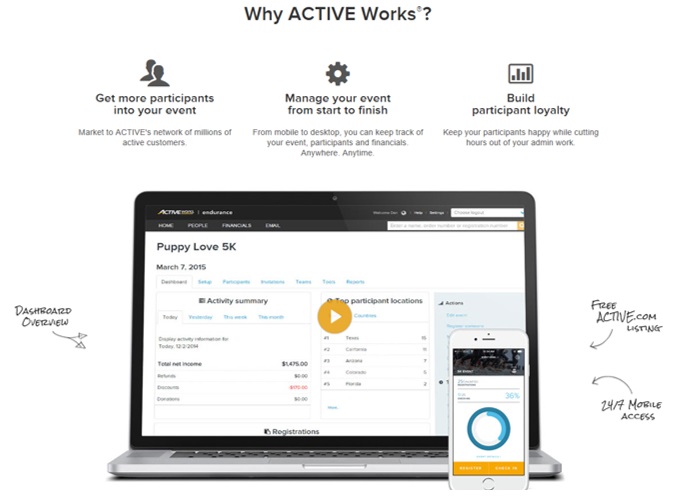
Bank Accounts
If you have an ongoing fundraiser it might be a good idea to open a separate checking account specifically for it. This makes for easy, streamlined accounting as all credits and debits are directly related to the fundraiser.
MBDL Meeting
If you will have this fundraiser again, you should have an MBDL meeting after your event has concluded and all donations have been collected. MBDL stands for More, Better, Different, Less.
- Things you/your committee will do MORE of next time
- Things you/your committee will do BETTER next time
- Things you/your committee will do LESS of next time
- Things you/your committee will do DIFFERENT next time
During this meeting you will debrief on all the aspect of the fundraiser. To help guide the conversation here are some aspects of your event you can explore:
- Organization
- Promotion (Cover each avenue your used to promote your race)
- Prizes
- Event Day Management
- Volunteers
- Collection
This meeting should include:
- Your committee
- A representative from those who participated
- A representative from the police department
Fundraising Timeline
Coordinating a road race includes some very time sensitive tasks. To help you keep everything moving along, here is a timeline will help make sure nothing slips through the cracks.
Coordinating a 5K Timeline - PDF
Sue Nowicki is an alumna of the 2014/15 Disney Parks Moms Panel. She is a team mom extraordinaire who has filled her time serving as secretary, navigator, head cheerleader, treasurer, athletic trainer and team psychologist for her daughter’s travel sports team for over 15 years before becoming a team owner. She is also a travel consultant for Looking Glass Travel specializing in Disney destinations. You can follow her on Twitter at @JazzinDisneyMom.
You can follow our pixie-dusted journey here: Facebook, Twitter, Instagram and Pinterest for more great Team Mom Lifestyle content.
